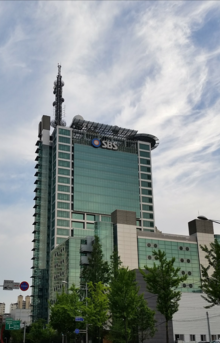Seoul Broadcasting System (SBS) (Korean: 에스비에스; RR: EseuBiEseu) is one of the leading South Korean television and radio broadcasters. The broadcaster legally became known as SBS in March 2000, changing its corporate name from Seoul Broadcasting System (서울방송; Seoul Bangsong). Its flagship terrestrial television station SBS TV broadcasts as channel 6 for digital and cable.
Quick Facts Native name, Korean name ...
Seoul Broadcasting System (SBS) |
 SBS Broadcast Center in Mok-dong, Seoul, the headquarters of Seoul Broadcasting System |
Native name | |
|---|
|
| Hangul | |
|---|
| Revised Romanization | Jushikhoesa Eseubieseu |
|---|
| McCune–Reischauer | Chusikhoesa Esŭbiesŭ |
|---|
|
|
| Formerly | |
|---|
|
| Hangul | |
|---|
| Revised Romanization | Seoul Bangsong Jusikhoesa |
|---|
| McCune–Reischauer | Sŏul Pangsong Chushikhoesa |
|---|
|
|
| Company type | Public |
|---|
| KRX: 034120 |
|---|
| Industry | |
|---|
| Founded | 14 November 1990; 33 years ago (1990-11-14) |
|---|
| Headquarters | , |
|---|
Area served | Worldwide, with a focus in South Korea |
|---|
Key people | - Yoon Se-young (Founder)
- Park Jung-hoon (President)
|
|---|
| Products | Television show |
|---|
| Services | Broadcasting
Web portal |
|---|
| Revenue | ₩792,884,228,900 (2015) |
|---|
| ₩42,152,487,870 (2015) |
|---|
| ₩34,884,042,815 (2015) |
|---|
| Total assets | ₩934,369,945,679 (2015) |
|---|
| Total equity | ₩91,262,910,000 (December 2015) |
|---|
| Owner | |
|---|
Number of employees | 1,141 (December 2015) |
|---|
| Parent | SBS Media Holdings |
|---|
| Subsidiaries | - SBS A&T
- Mediacreate Co., Ltd.
|
|---|
| Website | www.sbs.co.kr |
|---|
Close
Established on 14 November 1990, SBS is the largest private broadcaster in South Korea, and is owned by the Taeyoung Construction. It operates its flagship television channel which has a nationwide network of 10 regional stations, and three radio networks. SBS has provided digital terrestrial television service in the ATSC format since 2001, and T-DMB (Digital Multimedia Broadcasting) service since 2005.
After South Korea's democratic reform in 1987, the government moved to create a new commercial broadcaster in South Korea, the second after the Munhwa Broadcasting Corporation (MBC). Unlike MBC, previously a part of the Korean Broadcasting System (KBS) broadcasting sporting events like the 1986 FIFA World Cup, the new commercial broadcaster was to become a broad alternative channel for the public. SBS was founded in Seoul on 14 November 1990, and marked its establishment with initial experimental demo broadcasts, with test transmissions for its TV and radio channels following on 1 December 1990. On 20 March 1991, SBS started its regular broadcasts, launching SBS Radio's first regular broadcast on AM 792kHz.[1] On 1 December 1991, the 30th anniversary of MBC, SBS commenced its official broadcasts with the introduction of SBS TV at 10:00am in Seoul, designated as "The Day of Birth of SBS",[2] as broadcast by MBC on the program MBC Newsdesk.[3]
Initially, SBS was only broadcast terrestrially in Seoul and its surrounding areas. On 9 October 1992, the government began accepting applications for private broadcasting stations in other regions of the country. SBS planned for a television and radio broadcast affiliate network to air SBS programs on other new regional channels before its 5th anniversary. In 1994, the private Korea New Network (KNN) in Busan, Taejon Broadcasting Corporation (TJB) in Daejeon, Daegu Broadcasting Corporation (TBC) in Daegu, and Kwangju Broadcasting Corporation (KBC) in Gwangju were created, after government approval.[4] On 14 May 1995, SBS launched its national television network with new local affiliates, KNN, TJB, TBC, and KBC, airing SBS programming on the regional channels while local stations created local programming to suit the local residents needs.[5]
In 1996, an FM radio station was established to complement the existing AM station. On 14 November 1996, SBS Power FM began broadcasting on 107.7 MHz as a music-centric station. On 4 January 1999, the original SBS Radio on AM 792 kHz began broadcasting on FM as well. The station rebranded as SBS Love FM on 103.5 MHz, broadcasting simultaneously on AM and FM frequencies.[6] High-definition digital television was introduced in 2001. Digital Multimedia Broadcasting (DMB) was introduced in 2005.
SBS introduced its current logo on 14 November 2000, after its 10th anniversary celebration entitled "SBS 10th Anniversary Special: Thank You, Viewers". SBS also used the slogan "Humanism thru Digital" until January 2010, when a new slogan was introduced: "Together, we make delight".[7][8] On 29 October 2012, SBS TV became South Korea's second channel to broadcast 24 hours a day. However, this was discontinued in 2017, and the channel has reverted to daily sign-off routines overnight.
SBS dramas have been part of the "Korean wave", exported to many countries across the world. Sandglass has one of the highest viewership ratings in South Korea, and is considered the breakout drama for the network.[11] Other dramas that have enjoyed high viewership include Lovers in Paris, Trap of Youth [ko], Brilliant Legacy, Rustic Period, Temptation of Wife, The Heirs, and My Love from the Star.[12] SBS airs a variety of entertainment programs ranging from informational, comedy, music, reality, talk shows, and auditions. Many programs are popular throughout Asia, including X-Man, Family Outing, Running Man, Inkigayo, and many more.[13][14] SBS documentaries encompass a wide range of issues, from foreign affairs to the environment. Unanswered Questions [ko] (Korean:그것이 알고싶다/literal translation: I Want to know) premiered in 1992, and has since earned notoriety for its investigations from a journalistic standpoint. SBS also broke tradition by creating its flagship newscast SBS Eight O'Clock News, airing at 20:00 instead of 21:00, giving itself the slogan "News an hour earlier".[15] It also produces news-analysis programs such as Morning Wide, Nightline, SBS Current Affairs Debate, Curious Stories Y, and In Depth 21 covering the political, economic, social and cultural issues of the days.

